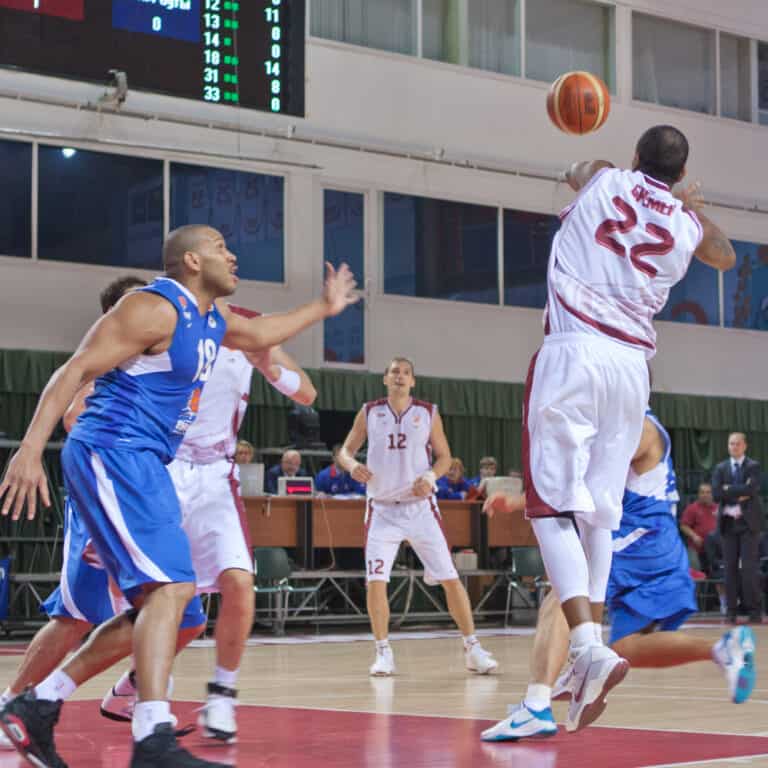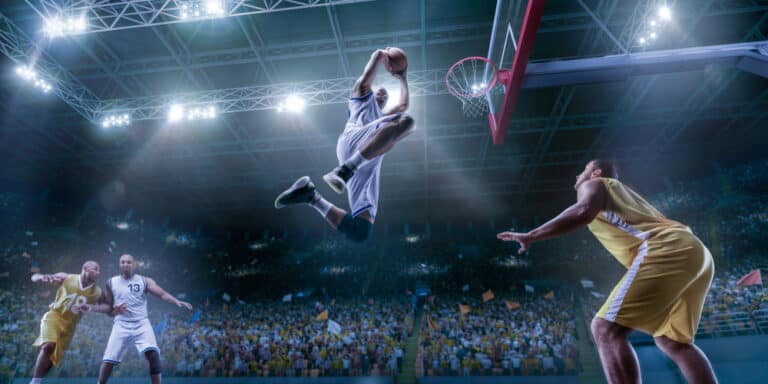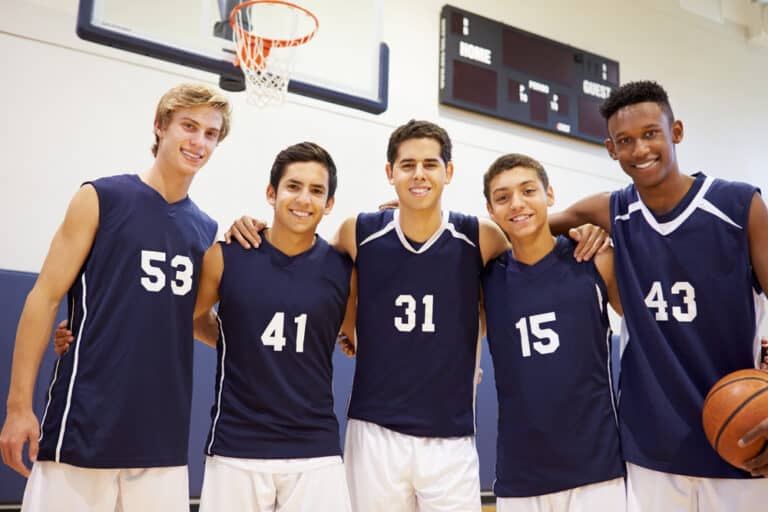Can You Use Your Forearm In Basketball? (And When It’s Allowed)
Editorial credit: Nadir Keklik / Shutterstock.com
Fairly and actively judging basketball games takes years of experience to achieve the level required. The speed at which plays happen, players violating their own “cylinder,” and other infractions happen very quickly and require a razor-sharp focus from the judges.
Basketball players are permitted to use their forearms to protect their faces if they are doing so to prevent injury or to absorb the impact of another player initiating a charge. Basketball players are not permitted to use their forearms to gain an advantage or restrict the other player.
The use of a player’s forearm is often controversial; however, the game’s rules are very clear regarding the circumstances when it may be used and when it constitutes a foul.
You Can Use Your Forearm In Basketball With Limitations
The difference between a foul and the legal use of a player’s forearm is governed by the official basketball rules for 2022.
There are three rules that dictate whether the use of the player’s forearm is allowed:
- Making Contact With An Opponent Using The Hand(s) And/or forearm (s)
- The Principle Of A Cylinder Surrounding The Players
- Players Cannot Wear Anything That Causes Injury To Players.
Making Contact With An Opponent Using The Hand(s) And/or forearm (s)
It is not always a foul to touch another player with the hand(s).
Rules Affecting All Players
It is permitted to use the forearms under the following circumstances.
- For a player to hold their forearms in front of the face as protection against an imminent impact.
- For a player to hold their forearms in front of the face or body to absorb the impact of another player charging.
No player is permitted to use their forearms to touch another player in the following conditions.
- If they use their forearm and hands to gain an advantage.
- The use of their forearms or hands to restrict the opposing player’s movement.
- It is not legal for players to use their hands, forearms, or arms to lock arms with or grab hold of the opposing player.
Rules Affecting Defensive All Players
Defensive players are subject to the following conditions.
- When the defensive players are in a guarding position and use their forearms or hands to impede the player’s (even if they don’t have the ball) progress.
- NO player is allowed to use their forearms or any part of their body to restrict or prevent the opposing player’s freedom of movement.
- Defensive players behind the offensive player are not allowed to use their forearms or any other part of the body to interfere with the opposing player from behind.
Rules Affecting Offensive Players Who Have The Ball
Offensive players possessing the ball are subject to the following conditions.
- An offensive player who has possession of a ball cannot use their extended forearms while dribbling it to prevent a player on the opposing team from gaining possession of the ball.
- Offensive players are not allowed to “hook” or use their forearms to restrain the opposing players and get an advantage.
- Offensive players dribbling the ball cannot “push off” an opposing player using the forearm or hands.
Rules Affecting Offensive Players Who Don’t Have The Ball
In addition to these conditions, the following conditions apply to offensive players who do not possess the ball.
- Offensive players who do not have possession of the ball are not allowed to use their forearms to obstruct the other player to obtain possession of the ball.
- Offensive players who do not possess the ball are not allowed to use their forearms to obstruct the defensive player from playing (or even attempting to play) the ball.
- Offensive players who do not possess the ball are not allowed to use their forearms to increase the size of their “cylinder” to create more personal space for themselves.
The Principle Of A Cylinder Surrounding The Players
The principle discussed in the rules imagines that a vertical cylinder surrounds the players on the court.
The Offensive Players Cylinder
The body parts of offensive players define the cylinder’s boundary (circumference).
- The front of the cylinder is defined by the palms of the player’s hands.
- The rear of the cylinder is the player’s buttocks.
- The side boundary of the cylinder is defined by the outer edge of the legs and arms.
The boundaries of the cylinder must be respected, which means the following restrictions to offensive players apply.
The arms and hands of the offensive player may extend in front of the player’s torso only to the point where they extend past the knees and feet. The player must extend the arms with the elbows bent to raise the forearms and palms held up in a defensive position.
The offensive players are not permitted to attempt to gain additional space by artificially extending the boundaries of their cylinder by spreading their legs and then causing illegal contact with a defensive player.
The Defensive Players Cylinder
Defensive players are not permitted to enter the offensive player’s “cylinder.”
In this regard, the offensive player’s “cylinder” is defined as follows.
- The front is defined by the position of the offensive player’s feet, knees that are bent, and holding the ball above the player’s hips.
- The offensive player’s buttocks.
- The sides of the offensive player’s cylinder are defined by the position of the outer edge of the player’s elbows and legs.
In practical terms, the offensive player must be allowed enough space to play the basketball within the boundaries of the cylinder.
Players Cannot Wear Anything That Causes Injury To Players
The rules state that no player is allowed to wear any object which has the potential to cause injury to any other player.
Amongst other items, this includes the following rules, which apply to wearing items on the arms and forearms.
- No guards made from plastic, leather, metal, or other hard material may be worn on the player’s head, hands, forearms, elbows, or wrists.
- Even fingernails must be trimmed close to prevent them from scratching other players.
- No bracelets, watches or other jewelry may be worn on the player’s forearms.

Which Body Controls Basket Ball And Set The Rules
The Federation Internationale de Basketball Amateur (FIBA) governs basketball and the applicable rules. USA Basketball is a member of FIBA.
The latest version of the rule came into effect on 1st October 2022.
The relevant sections which regulate the use of a player’s forearms are as follows.
- Article 33 Contact: General principles, section 33.11. Making contact with an opponent using the hand(s) and/or forearm (s).
- Article 33 Contact: General principles, section 33.1. Cylinder principle
- Article 44 Other equipment: section 4.4.2. Players Cannot Wear Anything That Causes Injury To Players.
Conclusion
It is permitted for offensive and defensive basketball players to use their forearms as long as it does not restrict the opposing players, provide an advantage, or present a risk to the opposing player.






